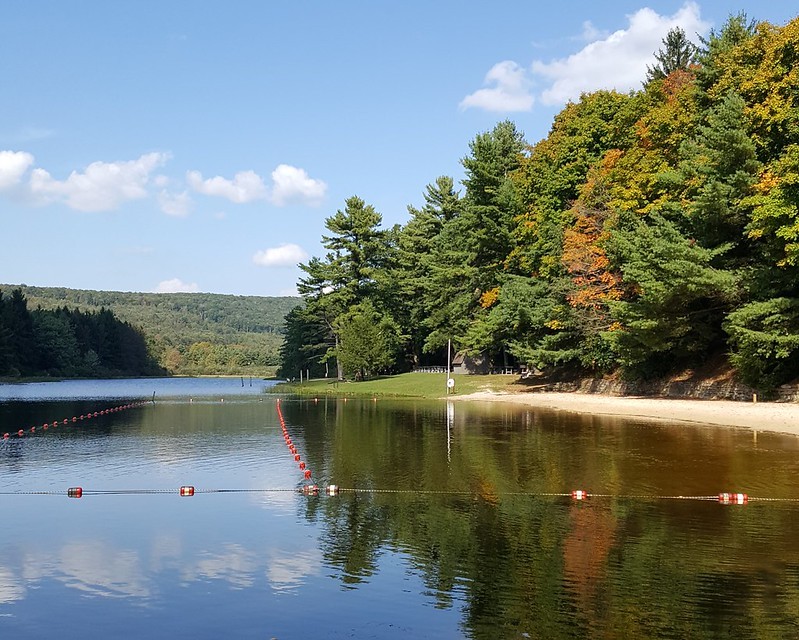New Germany State Park
Introduction
Text-to-speech Audio
New Germany State park is located in Garrett County Maryland and serves as a public recreation area spanning approximately 483 acres next to the Savage River State forest. The park offers visitors a diverse selection of activities all year round in a picturesque setting. There are beautiful trails for both novice and experienced hikers, lakes that are suitable for boating, swimming and fishing, family friendly campsites, and even pet-friendly cabins – but no cell service!
The immigrants who settled in the area during the 19th century named the area New Germany because it reminded them of the lands they left behind. These immigrants worked together and formed a farming and logging community. Two members of the community who were brothers, John and Charles Swauger, dammed Poplar “Lick” (local term for a stream) to create a lake later called Swauger’s Dam. This lake became the site of a sawmill and a grist mill (for grinding grain). These were both powered by utilizing water from the lake. The lake also provided ice in winter that was stored in an icehouse for summer use. This community continued logging and farming until the Great Depression compounded by depleted soil took a toll and the farmers sold their land to the federal government.
Images

Backstory and Context
Text-to-speech Audio
President Franklin D. Roosevelt established the Civilian Conservation Corps (aka CCC) as one part of the New Deal plan to support the country through the Depression year. Congress established the CCC in 1933 as a way to counter rampant unemployment by putting young men to work. The work these men accomplished included conservation efforts across the country, planting trees, and establishing recreational parks.
Camp S 52 formed in New Germany in June of 1933 with approximately 125 boys as one of the first CCC tent Camps. The crews spent the first year living in tents and began the work of replanting and restoring the depleted farmlands. The CCC crews drained the Swauger’s lake to clear out logs, stumps and debris that created swimming hazards. They removed the dam and built a bigger one that increased the size of the lake that was renamed New Germany Lake and stocked with fish establishing a beautiful site for fishing, boating and swimming.
The “tree Army” as the CCC crews were often called, planted thousands of trees and worked to bring forest fires under control. The crews built many of the park’s structures that are still in use today. Beginning with six barracks, recreation hall (still in use), Officer’s Quarters (now a vacation cabin), and the headquarters building.
Crews established recreation areas near the lake with a bathhouse, a boathouse, pavilions, and picnic areas that included tables and fireplaces. Roads, parking lots and water systems were added to support the use of these facilities. The CCC crews also established ski trails and slopes making New Germany one of Maryland’s first ski resort area.
All that remains of the Mill are the original footers and interpretive signage is in place. There is a footbridge on top of the dam providing an excellent view of the lake. The camp closed in 1938 and moved to the Meadow Mountain Camp. However, crews continued to return to New Germany until the camps closed in 1942 in order to complete forestry and recreation projects.
Cite This Entry
National Heritage Area, Appalachian Forest. "New Germany State Park." Clio: Your Guide to History. February 14, 2022. Accessed March 27, 2025. https://theclio.com/tour/2097/16
Sources
Accessed February 14th 2022. https://www.facebook.com/FriendsofNewGermanystatepark/ .
Accessed February 14th 2022. https://dnr.maryland.gov/publiclands/Pages/western/newgermany.aspx .
The Civilian Conservation Corps . Edition ISBN 9781530068548. Charles River Editors.
O’Connell , P. . Fighting for the Forest. Edition ISBN 9787534429338. Pearson Simon and Schuster, 2019.
Cohen, Stan . The Tree Army. Edition ISBN 978-0-933126-11-4. Mountain Press Publishing Co .
Accessed February 14th 2022. https://livingnewdeal.org/us.

